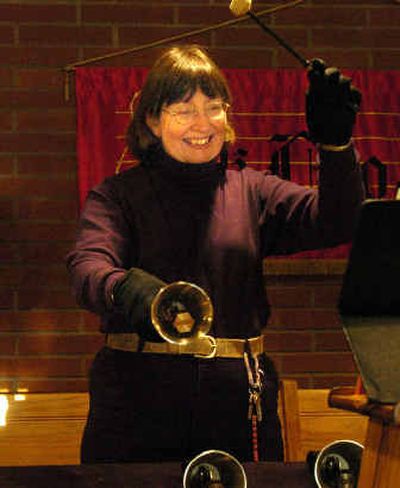Ring those chimes

In the early 1920s, P.T. Barnum, the great showman whose name is usually associated with circuses and side shows, brought hand bell ringing to the United States after hearing a bell choir in England. Ever the showman, he called his performers Swiss Bell Ringers and dressed them in Swiss costume. They were a ringing success, and Barnum made a lot of money. Jane Orto, director of the bell choirs at Trinity Lutheran Church and the instigator and driving force behind the Spring Ring, an annual gathering of area ringers, explains that the bell choirs came from England, not Switzerland.
She says that the bells are correctly called English hand bells and bell choirs had their beginnings with the bells that hung in the towers of Europe’s churches and cathedrals. Several bells, hung in a belfry, can be rung together or separately. A set of bells is known as a peal, and peals can vary in number from three to 12 bells. The art of bell ringing or “ringing the changes” became a popular “sport” by the early 1700s, especially in the British Isles.
Ringing bands formed and engaged in marathon contests that sometimes went on for 24 hours and became tests of physical endurance and skill. This writer remembers an evening spent at an English inn across from Lincoln Cathedral on the evening the bell ringers’ guild was practicing changes. It was a great experience but, well – loud.
Throughout the country villagers complained about frequent and lengthy practice sessions and, as a result, ringers began practicing indoors with hand-held, wooden bells. They also discovered that warm, indoor rooms were preferable to the ringing rooms of cold, damp bell towers.
A foundry in England cast the first tuned bronze hand bells, and interest among ringers gradually changed from practicing changes to ringing melodies.
Orto comes from a musical family. Her mother was an organist who played for skaters at a skating rink and also played theater organs when such instruments were common in movie houses. Orto and her husband, Gary, moved to Idaho in 1978.
She received her bachelor’s degree in music from Hillsdale College in Michigan and a master’s degree in music from the University of Idaho, which she earned while teaching music in the Coeur d’Alene public school system. She also taught general extension courses in public school music during the 1980s.
In 1986 she was diagnosed with lupus, an auto-immune disorder, but continued trying to teach. However, health problems finally forced her to give up teaching.
Leaving a lifetime of music and teaching was not easy, and she wanted to stay involved. Her mother, after hearing hand bell choirs herself, suggested the bells as a way to continue with music. Orto took the advice and got her first set of bells in 1988, began learning in 1990 and started her first youth bell choir at Trinity Lutheran Church in 1995. Today she directs the youth choir, an intermediate choir and an adult choir and is Spring Ring chairwoman.
Orto says bells are not hard to play. “If you can count, you are home free and you don’t have to worry about pitch.” Bells are automatically tuned with the casting process.
She also believes that bell playing has longevity. She says, “You can begin as a child and play throughout a lifetime.”
She starts children as forth-graders with chimes, which are not as expensive or fragile as bells. “A chime is much like a tuning fork and has a lighter sound than a bell,” she explains.
She does say that learning to play the bells takes commitment. Once children demonstrate responsibility, they move up to the intermediate level and join the bell choir.
Each member of the adult bell choir plays two bells, and some ringers learn to play four at the same time – two in each hand. This is made possible by the design of the English bell, which has a fixed clapper, meaning that it moves only on one plane and it has a restraining spring that keeps the clapper from resting on the side of the casing.
“Responsibility to the group is important, and responsibility in handling the bells is absolutely necessary.” she says, “They are expensive and as fragile as fine china.”
Choir members learn that are certain rules that must be followed in handling the bells. There can never be metal to metal contact – two bells hitting together. A bell can chip or crack and cannot be repaired. It must be replaced. A five octave set can cost over $16,000.
Gloves must be worn to protect the bells from oils on the skin and also to protect the ringer’s hands from blisters. No gum-chewing or candy-eating is allowed because spray from the mouth can damage the finish. For performance, the bells are arranged in octaves on padded tables.
The most common questions asked about the bells have to do with size and weight. Orto says the smallest is about 1¼ inches in diameter and weighs 4 ounces. The largest have a diameter of 15¼ inches. Bronze bells can weigh 15 pounds. Sometimes aluminum is used in larger bells to decrease weight
Bell choirs have become increasingly popular in the United states and around the world. This year’s Spring Ring attracted an audience of more than 500 to the afternoon performance.
In Coeur d’Alene alone, besides Orto, there are three other directors of bell choirs: Randy Keoner directs at Church of the King; Diane Thorton is at Coeur d’Alene Bible Church; and Judy Fleiger directs at First Presbyterian.
Orto believes that the growing popularity of bell ringing is attributable to the fact that participants don’t have to be accomplished musicians to participate. It’s something most people can do if they have the interest.
Besides, it’s fun.